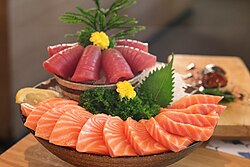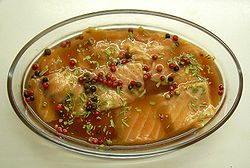| Name | Image | Origin | Description |
|---|
| Gravlax |  | Nordic | Raw salmon cured in salt, sugar, and dill. Usually served as an appetiser, sliced thinly and accompanied by hovmästarsås (also known as gravlaxsås), a dill and mustard sauce, either on bread of some kind, or with boiled potatoes. |
| Lohikeitto |  | Nordic (usually associated with Finland) | A creamy salmon soup consisting of salmon fillets, boiled potatoes and leeks, [13] [14] served hot with some dill. |
| Lomi salmon |  | Polynesian | A side dish consisting of fresh tomato and salmon salad. It was introduced to Hawaiians by early western sailors. [15] It is typically prepared by mixing raw salted, diced salmon with tomatoes, sweet gentle Maui onions (or sometimes green onion), and occasionally flakes of hot red chili pepper, or crushed ice. It is always served cold. Other variations include salmon, diced tomato, diced cucumber, and chopped sweet onion. |
| Lox |  | European (Ashkenazi) Jewish | A fillet that has been cured. In its most popular form, it is thinly sliced—less than 5 millimetres (0.2 in) in thickness—and, typically (in North America), served on a bagel, often with cream cheese, onion, tomato, cucumber and capers. Lox in small pieces is also often added and cooked into scrambled eggs, sometimes with chopped onion. |
| Rui-be |  | Japan | Salmon that is frozen outdoors, sliced like sashimi, and served with soy sauce and water peppers. [16] |
| Salmon burger |  | | A type of fishcake made mostly from salmon in the style of a hamburger. It is challenging to make and cook as the salmon requires a binder to make it stick together and is easy to overcook which makes it too dry. [17] Salmon burgers are especially common in Alaska where they are routinely offered as an alternative to beef hamburgers. [18] |
| Salmon tartare |  | | Appetiser prepared with fresh raw salmon and seasonings, commonly spread on a cracker or artisan style bread |
| Smoked salmon |  | | A preparation of salmon, typically a fillet that has been cured and then hot or cold smoked. Due to its moderately high price, smoked salmon is considered a delicacy. Although the term lox is sometimes applied to smoked salmon, they are different products. [19] |
| Salmon sashimi |  | Japan | Sliced raw salmon served with garnishes. Usually eaten by dipping in soy sauce and wasabi. |
| Salmon sushi |  | Norway, [20] Japan | Sliced raw salmon rolled with rice and sometimes nori (seaweed) as makizushi or placed on top of rice as nigiri sushi, served with garnishes. Usually eaten by dipping in soy sauce and wasabi. |
| Kippered salmon | | Hupa, Karuk, Yurok | Salmon smoked using fruitwood until cooked on the outside but raw on the inside, then canned and pressure cooked. Can be seasoned with red pepper and other seasonings. |



























